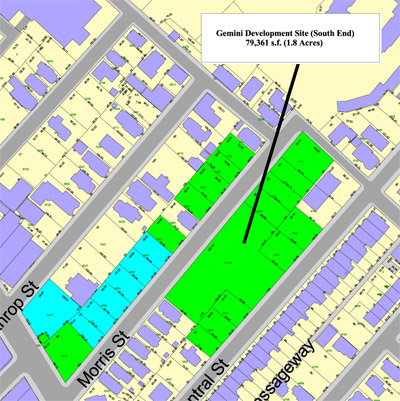
An article in today’s Republican shares a few details about a building now set for demolition, following a court decision on Friday. The 45-unit building, which is in the Hollywood section of the South End (highlighted in red above), has been vacant for over a year after being cleared of tenants and condemned at this time last year.
 According to the city’s Office of Planning and Economic Development, the densely-populated Hollywood district "is comprised of numerous four-story brick buildings built predominantly in the 1920s. Several of the buildings are now boarded and vacant."
According to the city’s Office of Planning and Economic Development, the densely-populated Hollywood district "is comprised of numerous four-story brick buildings built predominantly in the 1920s. Several of the buildings are now boarded and vacant."
The city’s current plan is to give attention to the area, working with the residents and other stakeholders. Such work could begin as soon as this spring, although it remains to be seen what form such attention would take. Presumably, at first, it would entail discussions.
Not far from the Hollywood section is the former Gemini textile mill site, a total of three acres located off Main Street between Morris and Central Streets. Now a brownfield, the city will commence a $200,000 cleanup expected to be done within a couple of months.

When the Urban Land Institute gave a presentation in Springfield last September, chair Maureen McAvey addressed this section of the city during a question-and-answer session. The initial Q&A footage provided by WGBY is truncated, but it appears that McAvey was prompted at first by a question about the availability of parking in the Hollywood district.
"There are three buildings in the Hollywood project which are boarded up and largely unoccupied," she said. "There may be some illegal occupation, but essentially, they’re unoccupied. There is no offstreet parking, at this point, for virtually all of the Hollywood project."
"The Winn [Development] project, a project of rowhouses along Central [visible in blue above, south of the Gemini site], is actually starting to be rehabbed at this point, and those buildings are upgraded. Along Main Street, you can see a number of commercial projects, which have real opportunities, as well as some vacant land."
Some of the "real opportunities" McAvey referenced include the strength of existing street-level retail in one of the most charming small-scale neighborhood sections the city has to offer.
"We started to look at that whole area," McAvey continued, "as one neighborhood, one area. It appears to us that the Hollywood buildings themselves—and some are single-family, as well as the large apartment buildings—is probably a little more dense than this community is used to, and than is comfortable in this community. It may be appropriate to take one or two of the buildings out. I don’t know—we looked at it with some degree of precision—we didn’t get in the buildings. We don’t know whether it makes sense to tear down the buildings that are vacant, or whether other buildings would make more sense. But there’s not much green space there, and there’s no offstreet parking. So that area needs to be looked at, sort of comprehensively, as a neighborhood, to think through what its role is, what it could be, what it should be."
McAvey went on, "We understand there’s about 1,000 units that are occupied. It’s not clear that [the tenants of those units] should be relocated, if they should. They need to be treated, obviously, with respect, and appropriate housing found."
"But there’s a lot of housing in the city," she said. "If you had to relocate people, it’s not clear that there would be no place to relocate them. It’s not that you’re 100 percent fulll, as a city."

Gemini site
"At the Gemini area?" McAvey said, "there’s an opportunity for brand-new construction. The site’s vacant. Some townhouses, some rowhousing. Something that perhaps empty nesters would come into. Seventy-five percent of all the households in America do not have children under 18 years of age. So only about 25 percent of the households have young kids. Some young people who have no children, some people over 55—many of these people have no children, and they’re interested in coming back to the city, and being able to walk to all the things the city has to offer."
"You could really do a mix of housing," McAvey concluded, "and it’s got commercial as well, in that area. It needs to be looked at, sort of, as a block, as an area, not just the Hollywood building and the Gemini site."


